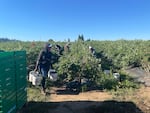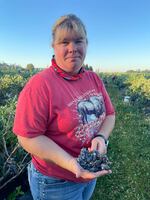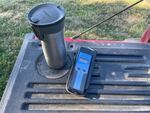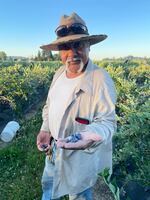Andrew Morton saw the weather forecast and decided to get ahead of the heat by switching up his schedule.
Morton, who works for a beverage and snack company in Wilsonville, started coming in for his warehouse shifts at midnight instead of his usual 4 a.m., because he wanted to beat the heat. But that didn’t work out like he’d hoped, once the heat dome landed over the Northwest.
“It is so humid and oppressively hot out here” he said in a recording of himself walking into work on the first hot night, getting sodas, candy and other snacks ready for delivery to vending machine locations.
Walking into work for his predawn Monday shift felt to Morton like he was working in a sauna.
“When I came in, I’m like ‘wow, it’s still pretty warm, I’m going to have to treat it as if it’s the middle of the afternoon on a warm summer day,’” he said.

Farmworkers preparing the blueberries they picked in a farm in Albany to get them weighed and ready to ship to a pack house on June 28, 2021.
Monica Samayoa / OPB
The entire Pacific Northwest endured a dangerous heatwave over the weekend shattering high temperature records across the board. In Portland, the all-time record of 107 degrees was broken three days in a row, ending with a new record high of 116 degrees on Monday.
And thanks to climate change, triple-digit, multiday heat waves are getting more and more common.
Working in this kind of excessive heat can be deadly and the Oregon Occupational Safety and Health Administration, or Oregon OSHA, is going through a rulemaking process to protect workers whose jobs keep them outside of climate-controlled settings.
Currently, there are general guidelines for protecting workers from excessive heat and an expectation that employers take reasonable measures like extra breaks and making drinking water available.
This is something Berries Northwest blueberry farmer Anne Krahmer-Steinkamp makes sure her crew knows.

Berries Northwest's Anne Krahmer-Steinkamp finds damaged blueberries in her farm in Albany that have been scorched by the heat wave on June 28, 2021.
Monica Samayoa / OPB
“We have water at all the tables and we’re always telling them to drink their water. We allow them to take breaks whenever they want,” she said. “They can also leave wherever they want.”
She walks around with a handheld thermometer, sticking it into the soil to take the temperature. If they go above 90 degrees, she tells her berry-pickers to go home.
On Monday crews were working as early as 5 a.m. But by 9 a.m. Krahmer-Steinkamp’s thermometer reading topped 90 degrees — so she called it quits and sent her crews off to get out of the heat. That puts her in a tough position as a business owner — her unpicked berries are left to bake in the sun instead of being harvested and sold.
“I lost 60 acres. There’s no way I can do fresh market quality,” she said Tuesday morning.
German Facundo Palacios has worked at Berries Northwest in Albany for 12 years. He’s the ranch manager and in charge of irrigation. He’s never had to work through such an intense heat wave so early on in the season. Palacios said he is in favor of some type of rulemaking from Oregon OSHA but also fears that the rules would only go so far.
Right now, the state’s rules give no assurance that workers will be compensated for wages lost when excessive heat requires them to leave their job sites. Palacios said farmworkers don’t have the financial cushion to give up paid work hours; with bills to pay and families to support, an unpaid day off is not an option.

Two items that Berries Northwest owner Anne Krahmer-Steinkamp keeps close by on hot days: a beverage container and a thermometer she uses to monitor how hot her farm is getting. Photo taken on June 28, 2021.
Monica Samayoa / OPB
“So many workers have families, and they don’t want to stop working. For us having rules would be nice, but you know not everyone has a savings,” he said.
Palacios makes sure to constantly remind everyone to drink lots of water and take as many rest breaks as they need during the hotter times of the day.
But not every farmworker has an employer like Berries Northwest that makes sure their employees are not getting sick from the heat.
Leticia Licona works at a farm in Independence. The heat forced her to take Monday off which cost her a day’s pay.
“Tenemos que aguantar, no nos queda de otra,” she said. Translated from Spanish to English: “We have to put up with it, we have no other choice.”

Berries Northwest Ranch Manager German Facundo Palacios finds damaged blueberries that have been scorched by the heatwave. Photographed on June 28, 2021.
Monica Samayoa / OPB
It’s an increasingly deadly choice that farmworkers are facing as the planet heats up: to prioritize their wages over their health. One farmworker was found dead on the job at a farm in St. Paul, north of Salem. Oregon OSHA listed the death as heat-related.
Reyna Lopez is executive director of the farmworker advocacy group Pineros y Campesinos Unidos del Noroeste, or PCUN. She said it is shameful that a farmworker died over the weekend. Death on the job is avoidable and no one should have to decide between their health or a paycheck.
“It all happened while we were making calls to get some emergency action,” she said. “Calls were coming from PCUN and our partner organizations and we were met with resistance.”
Lopez said the death highlights the need and urgency for emergency rules and a strong standard across the board around working in excessive heat.
Licona wants employers to give more breaks and make it easier for workers to access to shade and water during periods of extreme temperatures.
But for some, those extra breaks might not be helpful, depending on the working conditions.
Dana Carstensen is a hazardous waste technician at Metro’s Oregon City transfer station. He wears personal protective equipment like gloves and a full bodysuit that he describes as “wearing a woven plastic bag” to protect himself from the toxic materials people bring in for disposal, like paints and cleaning solvents.
“It can’t breathe. As soon as you put it on, you start sweating,” he said.
By 2 p.m. during his Saturday shift, he was dizzy, Carstensen said. Back at work the next day it took only until 9 a.m. before the sensation returned.
“I would have to sit against something or lean against something. Another one of my other coworkers was having nausea and the thing is people were still coming in,” he said.
Carstensen said his employer was making sure people were getting enough breaks but because of his suit— he couldn’t go into the air conditioned breakroom, unless he completely took it off. That is time consuming, he said, so he spent those extra breaks sitting in the hot warehouse.
Oregon OSHA Public Information Officer Aaron Corvin said the agency is considering the adoption of temporary rules for this summer but are still currently working on draft rules.
“It’s been in development. Of course there was a delay due to the pandemic. We actually hoped to have this rule process further along,” he said.
Over the next several months the agency will continue to work with advisory committees and stakeholders to collect more information for the rulemaking process.
